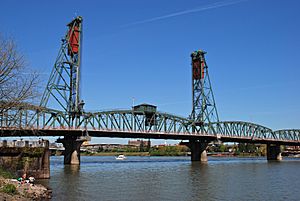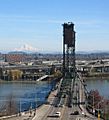Hawthorne Bridge facts for kids
Quick facts for kids Hawthorne Bridge |
|
|---|---|
 |
|
| Carries | Vehicles, pedestrians, cyclists |
| Crosses | Willamette River |
| Locale | Portland, Oregon |
| Maintained by | Multnomah County |
| Characteristics | |
| Design | Parker truss with a vertical-lift span |
| Material | Steel |
| Total length | 1,382 feet (421 m) |
| Width | 73 feet (22 m) |
| Longest span | 244 feet (74 m) |
| Number of spans | 6 (excluding concrete girder approach spans) |
| Piers in water | 6 |
| Clearance below | 49 feet (15 m) closed 159 feet (48 m) open |
| History | |
| Opened | December 19, 1910 |
| Statistics | |
| Daily traffic | 30,000 |
|
Hawthorne Bridge
|
|
| Location | Portland, Oregon; Willamette River at river mile 13.1 |
| Built | 1910 |
| Architect | Waddell & Harrington |
| MPS | Willamette River Highway Bridges of Portland, Oregon |
| NRHP reference No. | 12000932 |
| Added to NRHP | November 14, 2012 |
The Hawthorne Bridge is a special kind of truss bridge that can lift its middle section. It crosses the Willamette River in Portland, Oregon. This bridge connects Hawthorne Boulevard and Madison Street.
It is the oldest bridge of its kind in the United States that still works. It is also the oldest highway bridge in Portland. Many people use it every day! It is the busiest bridge in Oregon for bicycles and public transport. Over 8,000 cyclists and 800 TriMet buses cross it daily. The bridge became a historic landmark in November 2012.
Contents
How the Bridge Works
The Hawthorne Bridge is 1,382 feet (421 m) long in total. It has five parts that stay still and one part that lifts up. This lifting part is about 244 feet (74 m) long.
The bridge was first 63 feet (19 m) wide. It had two sidewalks that were five feet wide. In 1998, these sidewalks were made wider. Now, they are 10 feet wide, making the whole bridge 73 feet (22 m) wide.
Huge weights, weighing 880,000 pounds (400,000 kg), help lift the bridge. They hang from two tall towers, which are 165 feet (50 m) high. Two powerful 150-horsepower motors make the bridge lift. On average, the bridge lifts about 120 times each month for boats to pass. When the river water is low, it lifts even more often, about 200 times a month.
About 30,500 vehicles crossed the bridge every day in 2001. The company Waddell & Harrington designed this bridge. They also designed the Steel and Interstate bridges in Portland. A man named John Alexander Low Waddell invented the modern vertical-lift bridge.
Bridge History
The Hawthorne Bridge opened on December 19, 1910. It cost $511,000 to build. It replaced an older wooden bridge from 1900 called the Madison Street Bridge. The bridge and Hawthorne Boulevard are named after Dr. J.C. Hawthorne. He helped start Oregon's first mental hospital.
Changes Over Time
At first, streetcar tracks were on the outer lanes of the bridge. In 1931, they were moved to the center lanes. The bridge's surface was changed from wood to steel in 1945.
In 1985, parts that help lift the bridge were replaced. From 1998 to 1999, the bridge had a big upgrade that cost $21 million. The old steel surface was replaced, and the bridge was repainted. All the old lead-based paint was removed. New paint was put on, which should last for 30 years. During this upgrade, the sidewalks were made wider. This made it easier for people to ride bikes across. The bridge was closed for a year during this work.
The bridge was black when it was first built. In 1964, it was painted yellow. During the 1998–99 upgrade, its color changed to green with red trim.
In 2001, the sidewalks on the bridge were connected to the Eastbank Esplanade. This is a path along the river.
Bridge in Movies and Future Plans
A movie called The Hunted (2003) had a scene on the Hawthorne Bridge. It showed a MAX train. But MAX trains do not actually cross this bridge. The movie used two buses that looked like a MAX train.
The new bridge surface put in place in 1998–99 was made strong. It was designed to hold modern streetcars or light rail trains in the future. However, TriMet later decided to build a different bridge, the Tilikum Crossing, for its new MAX line. So, it is now unlikely that trains will ever cross the Hawthorne Bridge again.
In August 2012, a special machine was put on the bridge. It counts how many bicycle counter|bicycles cross. This was the first such counter in a U.S. city. A group called Cycle Oregon bought it and gave it to the city. The bridge was added to the National Register of Historic Places in November 2012.
Gallery
Images for kids
See also
 In Spanish: Puente Hawthorne para niños
In Spanish: Puente Hawthorne para niños








